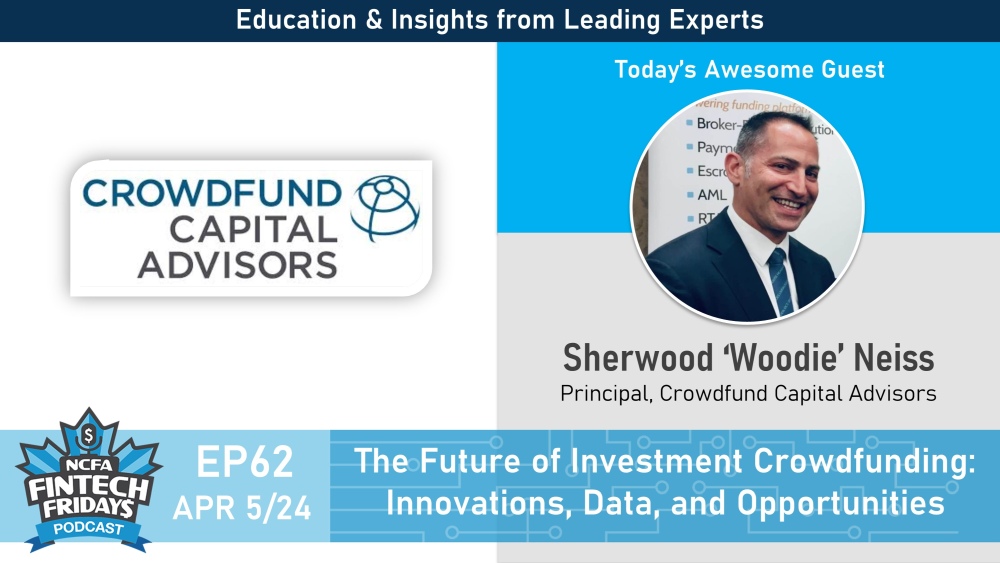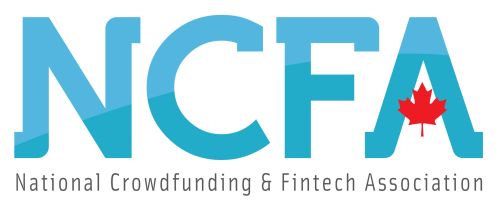About NCFA Canada | Craig Asano | Apr 5, 2024

 EP62 Sherwood ‘Woodie’ Neiss
EP62 Sherwood ‘Woodie’ NeissApr 5, 2024: NCFA’s Fintech Fridays podcast episode 62
The Future of Investment Crowdfunding: Innovations, Data, and Opportunities
Featured Guest:
SHERWOOD ‘WOODIE’ NEISS, Principal, Crowdfund Capital Advisors (LinkedIn)
Mr. Neiss, based in the US, is at the forefront of the investment crowdfunding industry, from issuance to data analysis, to secondary trading and liquidity. He co-authored the “Crowdfunding Exemption Framework,” which became the basis of Title III of the U.S. JOBS Act to legalize equity and lending-based crowdfunding. He co-founded Crowdfund Capital Advisors (“CCA”), a consulting firm serving certain governments and multi-lateral organizations, including the Inter-American Development Bank, the World Bank, governments of Chile, Malaysia, Israel, and the UAE. He is also a co-founder of GUARDD, the EDGAR of financial disclosures for private companies, and is a General Partner of D3VC; a Venture firm focused on diversified investing among investment crowdfunding issuers. He is the chief architect of the CCLEAR Regulation Crowdfunding Database, which tracks and monitors online security transactions for investors, regulators, platforms, and the media. Before crowdfunding, Mr. Neiss co-founded FLAVORx, Inc., acted as its chief financial officer, and won Ernst & Young’s Entrepreneur of the Year award, as well as the Inc. 500 award three years in a row. He’s also a long standing advisor at NCFA.
About Crowdfund Capital Advisors
Crowdfund Capital Advisors (CCA) is a crowdfunding advisory, implementation and education firm founded by Jason Best and Sherwood Neiss, the leaders of the securities-based crowdfunding movement. CCA provides comprehensive advisory solutions to both public and private institutions.
Links
[embedded content]
About this episode
In this enlightening episode of Fintech Fridays, Season 4, Episode 62, host Craig Asano, founder and CEO of NCFA Canada, sits down with the distinguished Sherwood ‘Woodie’ Neiss, a pioneer in the investment crowdfunding industry and an advisor to NCFA. Together, they delve into the evolution of investment crowdfunding, its impact on startups and investors alike, and the potential for future growth. Woodie shares his journey, from the inception of crowdfunding regulations to leading the charge with data-driven insights and AI technology in investment strategies. Listeners will gain an insider’s perspective on the latest developments, the significance of data in shaping the industry, and the role of technology in advancing investment opportunities. Whether you’re an investor, entrepreneur, or fintech enthusiast, this episode offers a comprehensive look into the dynamic world of investment crowdfunding, revealing how it’s reshaping the landscape of finance and opening new doors for innovation and growth. Enjoy!!
Duration: 45 mins
Episode Jump Links:
00:00 Episode introduction
03:22 Meet Sherwood ‘Woodie’ Neiss
04:55 Investment crowdfunding and its evolution
06:34 Genesis of D3VC.ai, AI driven venture fund, and GUARDD
11:40 RegCF data access, reports, algorithms
13:47 Current state of U.S. Regulation Crowdfunding 2024
15:00 Impact of Crowdunding, innovation, job creation, economic stimulus ($6.8 billion)
16:15 Value creation, circular impact and velocity
18:50 JOBS Act 4.0, RegCF regulatory improvements
21:25 Investment Crowdfunding vs Angel-VC-seed/pitchbook
22:00 RegCF attracting more mature issuers and investors, removing FUD
23:38 RegCF diverse and inclusive, 41.7% offerings from women or minority
26:00 RegCF is scaling towards $1 billion annually
29:18 Platform dynamics and opportunities
31:28 Global expansion and tokenization
35:30 AI and technology’s impact on RegCF markets
37:12 How to get started in industry, job insights and opportunities
40:05 Rapid fire questions
42:25 How to get in touch with Woodie
43:41 Episode close
Subscribe and tune in each Friday to check out the latest movers and shakers in fintech. Listen to more podcasts here:
Season 1 | Season 2 | Season 3 | Season 4 | and weekly newsletter
Fintech Friday Transcript of Episode 62:
SHERWOOD ‘WOODIE’ NEISS, Principal, Crowdfund Capital Advisors
Intro: Welcome to fintech Friday’s a weekly podcast brought to you by the National Crowdfunding and Fintech Association of Canada and partners. Covering all things fintech, blockchain, AI and alternative finance.
Craig Asano: Hello everyone. My name is Craig Asano, the founder and CEO of NCFA Canada, welcoming you to another episode of Fintech Fridays. This is season four, episode 62 of NCFA’s weekly podcast together with partners, where we uncover the latest and greatest and sit down with fintech founders, investors and talk about innovations, the developments, news and in today’s instance, the latest and greatest in Investment Crowdfunding in 2024. Today we have an incredible guest. He’s been on here before, so don’t be shocked if you recognize Mr. Sherwood Neiss, aka ‘Woodie’. So I’m going to from this point on, refer to him as Woodie. It’s a very affectionate, nickname, but he’s based in the US, he’s also an NCFA Advisor, but I cannot think of someone better who’s at the forefront of investment crowdfunding industry and has been so since its inception. So they’re involved, and Woodie particularly, with data analysis right from Stem to stern of all aspects of crowdfunding. And they specialize in investment crowdfunding, secondary trading, liquidity, all the latest, topics. So, a long time ago, uh, we even had, for those of you who might actually have been there, Woodie, we flew him up. He came out to Vanfunding conference in Vancouver, talked about, uh, what he was doing at that time. Fast forward many years into the future, we have the privilege of looking at the data. Everything’s data driven, a lot more insightful. There was a lot of unknowns, I wouldn’t say, looking back, a tremendous amount of risk. But we’re very excited to dig in to the latest data of what’s happening in investment crowdfunding and also cover off the future. So, just very quickly, because, we do have a hard stop at 45 minutes for this podcast today. And I just want to say that Woodie has been an author. He’s been a global speaker. He’s launched a variety of crowdfunding related brands, and we’re going to give him an opportunity to talk a little bit about, Crowdfund Capital Advisors. What’s going on there? He’s the co-founder of a company called GUARDD. So we’ll let him talk about that later. He’s got CCClear or all the regulation crowdfunding data project on the go and all the data pipelines and partnerships with all the various data sources, as well as his background. He was always, even pre-crowdfunding, he had won awards. He’s Ernst and Young’s entrepreneur of the year award. I bet you you don’t hear that as as often as you do crowdfunding these days, Woodie. But he was a triple (3 years in a row) Inc 500 recipient as well. So, Woodie, I just want to welcome you back to the show. Thanks for agreeing to sit down to share your knowledge and experience with us.
Sherwood ‘Woodie’ Neiss: Hey, it’s great to be here, Craig. It’s just funny story, if you remember, I was late for the event in Vancouver because I had told the immigration people that I was here in Canada to legalize crowdfunding, and so they detained me. And then they they wanted to know everything that I was doing. And I was just like, maybe I used the wrong word, and so I, showed up to your event like ten minutes late but it made for a funny story when I got on stage.
Craig Asano: Yeah, it was very uncomfortable. I remember I was sitting there at the podium. You were the keynote speaker, and I just had to cover off ten minutes. That’s okay. We’ve been there and done that. but, as just someone who’s so involved with the space, very few OGs I guess we can say, that can sit down. Actually, both you and I and reminisce about old times. We always say it that we’d like to do sort of an episode that’s just storytelling What it was like and more shoot from whatever is on the mind but today we’re a little bit more focused because we want to cover off the report. We want to dig into the data, find out what’s going on. But to kick things off, like we always do with with the format of the podcast here, we just give the speakers an opportunity to talk about, how you got involved with the sector that we’re covering. Today it’s all about investment crowdfunding. What was that journey for you? What were the motivations? And maybe you can kick it off with a very high level definition from your perspective, the guru, what is investment crowdfunding and what are you doing with all these other projects you got on the go?
Sherwood ‘Woodie’ Neiss: Investment crowdfunding is really Kickstarter, Indiegogo, but with securities regulations attached to it. So instead of people giving money to people with good ideas, people are investing money in people that have great business ideas. And in exchange for that, you’re getting either an equity instrument or you’re loaning money, so it’s a debt instrument. This industry really started in 2016 here in the United States. It was something that, of course, accredited investors could be doing prior to this. It couldn’t happen online but what we did in the Jobs Act of 2012 was to open the door to both retail investors as well as general solicitation. So now we enable these funding platforms that look like Kickstarter and Indiegogo, but are now regulated by the SEC and overseen by FINRA here in the United States to actually be a matching service. And so people with great ideas can list their businesses up there to raise capital. Investors can look at these deals. There’s all these disclosures related to it. That’s what we sort of capture information on 125 data points on every single company, and we’ve been doing that since 2016. We write this annual state of the investment crowdfunding industry report. It’s only 150 pages long this year. So you could see, like in the first year when it was eight pages long, the industry’s only grown just a tiny bit since then. No, it’s grown tremendously and I think actually one of the things that might be helpful in this conversation is maybe if I share some of the slides, related to that as well.
Craig Asano: Yeah, absolutely. Did you want to talk about what you’re doing I’m kind of interested to hear a little bit about the D3VC and the definition that I got for that project. It’s all around AI venture and it’s on top of the investment crowdfunding industry. So what’s going on there?
Sherwood ‘Woodie’ Neiss: So, we wrote the law. We wrote the dummies guide to investment crowdfunding. We wrote the world Bank report. We traveled to 43 countries around the world. When the industry launched in 2016, we launched the database that we call CClear, and that collects the information on every company that’s raising money online. That data in the beginning, was just so we could track what was happening in the industry, with all these offerings, because there’s only a certain amount of information that the SEC collects and so we wanted to expand upon that. Have things like what industry are you in, what valuation are you does the company have if they’re doing multiple rounds of financing online, that really becomes a valuable information. As this data set grew, we realized a few things. So we were just sitting in front of our computers every day looking at the new companies coming in, and we’re thinking, wow, you know, fascinating company. You know, team that’s got great experience. They’ve clearly done this before. They’ve raised VC capital. I would invest in them. with 8000 companies that are doing this, it gets to be a little overwhelming. So which ones do you decide to invest in? And with the beauty about machine learning and artificial intelligence and these large language models that we’re seeing today is you can take data and you can feed it into these algorithms, and you can train these algorithms to look for signals depending on what you’re doing. In our case, I sat down with three PhDs that are in data science, and I said, listen, I want you to take the data that we have, and I want to develop an algorithm that compares the companies in the data set that have graduated either out of it or gone on for follow on rounds of financing at a higher valuation to companies that are coming into the data set. So when they come in, I want to look at all the data that we have on them to see if there’s signals that match those companies that have gone on for great things and if there are those signals there, then we want to have that, algorithm feed us up a weekly report that tells us which companies we should apply a human layer of diligence to. Because algorithms are great when they’re looking at data, but that’s very quantitative. It’s very black and white. What we are trying to do is use take the data, let’s take the human element out of that. A machine can do all that. You tell us which ones we should look at, and then we’ll do our own human layer of diligence around it. So D3VC is an AI driven venture fund where we’ve taken all our data and we use it to look for deals on a weekly basis that we should be doing diligencing. And it’s really fascinating. I mean, the companies that are in the data set are not startups that are unproven. These are early stage companies that have proven business models. They’ve got patents pending on a lot of their technology. A lot of them are at first revenue and so they’re looking for money now to scale. And this is a great place to sort of play in and invest in because, if you’re in this early stage investment arena, you know that early stage investment far outperforms late stage investment. I think it’s 19.1% to 11.7% or something like that. So there’s a there’s a great delta there to get in at an early stage. So we’re trying to apply AI to what we’re doing with this investment thesis. That’s D3VC. So the other flip side of this is, is when do I get out of these investments. You know, do I have to sit on this investment until the company has an exit, a sale, a merger, an IPO? And within the regulation that we have here in the United States, we put a 12 month holding period on these securities, after which they can be freely transferable. Now, the problem at that point is you just can’t sell it to anyone. You actually have to go through a process, and you usually list it on what we call an alternative trading system. But in order for these securities to trade on an ATS, they have to comply with state securities laws as opposed to federal securities laws. And the state securities laws require that companies do ongoing disclosures so that investors, when they’re looking at a company to buy or sell that stock, they have all the information, the most recent information on them. And so GUARDD is a company, a fintech company that we built to actually collect current information on companies that want to sell their securities on these ATS’s so that they can comply with state securities laws that freely allow these securities to trade in all 50 states here in the United States. So we’re at this sort of, you know, convergence of data, liquidity and venture capital. And all three of them coalesce under Crowdfund Capital Advisors.
Craig Asano: That’s awesome. So if any of our listeners like investing in investment crowdfunding companies, can they access the intelligence that’s coming out of the D3VC fund, and do they just get in contact with you there?
Sherwood ‘Woodie’ Neiss: Yeah. So it’s a venture fund, so like any venture fund people are investing into the fund as an LP, and so that’s a typical fund structure. So you know, we talk to people all the time that are interested in that. But people can also access the information that we produce through CCLEAR through a lot of what you’re seeing behind me, which are reports that we publish, we have a daily, uh, a weekly tear sheet, which is free for anyone to get that shows percentage changes and what’s happening in the marketplace. We have the biweekly report that really digs into what what’s happening over a two week period and compares that. You can see what’s happening in terms of investors investment sentiment, deal flow. So it’s high level and then we’ve got a monthly report that really digs into like the top ten offerings. You’ve got an industry breakout there where we dig into software industry and show the trends over the past 12 months in that industry or sector and we’ve done that for restaurants. We’ve done it for beverages, we’ve done it for health care. So that’s another report that people can subscribe to. And then I think the coolest thing that we have, which is a direct correlation to D3VC is our capital pulse ratings report, and so each week that comes out with the top 15 offerings that our algorithm says that we should look at, it’s not necessarily the ones that we will be investing in because like I said, we do our human layer of diligence. But it’s a great tool for people that are interested in just seeing, you know, you’ve got an algorithm that’s already looking at this. Maybe I can use that to help my investment decision.
Craig Asano: Fantastic. Well, I think this is a perfect segue to actually crack open that report in terms of slides and have a look at what kind of data we’re tracking and, you know, get some insights in the trends. And if we have a specific question, we’ll maybe just pause you here and there, but we’ll spend a little time going through at a high level what your, your take on some of the key slides and where you think it’s headed.
Sherwood ‘Woodie’ Neiss: Okay. Um, I think you see the whole slide thing right now. Yeah.
Craig Asano: Got the whole slide and, yeah.
Sherwood ‘Woodie’ Neiss: All right. So again this um, this trends report, it was it’s 200 slides long. Anyone can download it. Um, that QR code will take you right to where you can download those 200 slides related to the 150 page report. It’s completely free. This is an abbreviated version of it. I am just going to quickly fly through a few things on it that are of, I think, of interest, Just the highlights and this is as of December 31st, 2023, there were 6800 issuers that ran 8000 plus offerings. So that means issuers are running multiple rounds online. We’re seeing that more and more, which means that people are finding investment crowdfunding to be a viable means to access capital. And right now, of course, you know, we’re almost the end of March. We’re over 7000 issuers. We’ve got 8300 deals taking place. So you can see that that compounded annual growth rate at the bottom there, that 59% is really what’s happening. This industry is not slowing down. It is just getting traction. Whether you’re looking at it from the number of deals, the capital that’s flowing in or the number of checks that are being written. Now, again, we only focus on what’s happening in the United States. So the data that you’re looking at really just shows you how this is democratizing access across the United States. With 1800 cities that have been funded, we’ve had 2.2 billion. It’s over 2.3 billion now as of March, invested into these companies that have been successful with investment crowdfunding. There’s been over 2 million investors that have written checks and these companies are creating jobs and they’re pumping money into local economies all across the nation. Those are two critical things that governments, local governments, state governments, federal governments should be focused on. Because if you’re looking at how you can stimulate not just entrepreneurship, innovation, but jobs and economic stimulus, this is a great way to do it by promoting, investment into startups and small businesses. These companies, for the most part, when they raise capital, hire people, okay. A lot of it goes into hiring people. A lot of it goes into scaling a business. That’s why so many jobs have been created. But it’s not just direct jobs. It’s indirect jobs that companies use because they have to have service providers come in and help them with their business. These companies are, you know, they take in money, but they’ve got a whole expense expense lines on their PNL statement. And those expense lines are really money that’s being pumped back into these local communities, and that’s really important because that money circulates in these local communities. Right now, it’s about $6.8 billion annually. So you can see we’re having a sizable impact on what’s happening. We think, granted, our economy’s tremendously huge, but $6.8 billion is nothing to sneeze at. The other final thing on this slide that’s really important to point out is these companies start at an early valuation, a very low valuation typically, and then they grow and as they hit their milestones, they can raise money at a higher valuation. So the latest valuation related to these companies that are raising money online is $75.6 billion. So what does that mean? It means that when these companies do have their exits, someone’s going to get rich because that $75.6 billion is tied up, but it will be returned to investors. So we love that sort of part of the story. The other thing about this is the industry started here in 2016. So we’re in our seventh year of it. If you look at venture investing, they have a 7 to 10 year horizon because that’s usually when the exits start to happen. That’s what we’re seeing here in the United States. And so we’re starting to see these companies being acquired, go public. And that’s where these returns are starting to happen for investors. So we’ve got the 2016 vintage starting to have their exits. We’re going to start seeing the 2017 and 2018 coming up. And remember I told you there’s more deals happening. You know, we started with just a few deals in 2016. So you can see the velocity of the exits will be rapidly increasing over the next few years as well.
Craig Asano: That’s fantastic. Before you go on to the next slide, just go back for a second. How supportive has the US government been to investment crowdfunding and what are they doing? Are they funding education? Are the economic development agencies involved with promoting investment crowdfunding as a source of job creation, everybody. Just looking at these numbers, I’m just interested to hear your perspective on in 2024 or maybe 2023-24, in current times, how involved is the government in promoting crowdfunding?
Sherwood ‘Woodie’ Neiss: Not at all.
Craig Asano: Not at all. Okay, so that’s an interesting response because through the media we’ve seen the original Jobs Act and we’ve seen an evolution of sorts. And we catch wind of the Jobs act is evolving. They’re constantly tweaking the rules. And now we got a Jobs Act I think it’s called 4.0 Can you provide your perspective on how that might impact investment crowdfunding markets, maybe not the, or are they more around the laws?
Sherwood ‘Woodie’ Neiss: So currently in front of Congress, there’s a bill that passed the House called H.R. 2977. And a part of it is includes improvements to regulated investment crowdfunding that would increase the cap from 5 million up to 10 million. Also have fixed some things in there that, were part of that created problems like funding portals could be liable for material misstatements but in fact, if, you know, funding portal is just a listing agent, they’re not doing diligence on the details of an offering that’s really for the investors or the crowd to do. So there were fixes like that in there, but the reality of things here in the United States is quite dismal when it comes to policy happening. We’ve got such a divided Congress. No one wants to have the other side look like they’re getting a win and so this passed the House on strict party line votes, essentially. And the House is Republican controlled right now, so all the Republicans voted in favor of that, and currently the Senate is controlled by Democrats. So we are trying to get the message out there that this is good for our economy. But again, I don’t think any Democrats want to show Republicans that they can have a win and so I don’t think this is much opportunity for anything happening in the Senate until something changes here in the United States.
Craig Asano: Well, caps of issuer caps of 5 million and potentially 10 million are staggering numbers when you compare them to the Canadian, uh, investment crowdfunding landscape. So that was just one of the points that I wanted to flesh out there but okay, back to you, to the slides. Okay.
Sherwood ‘Woodie’ Neiss: All right. So let’s just hit on a couple of these things. This shows you the deal flow over time. I told you in 2016, that’s when the industry started, you could see that there was less than 250. It’s steadily grown in 2023 was a tough year here in the United States for investing, whether you’re in venture capital or in investment crowdfunding. I think a lot of these issuers saw that as well and decided to hold back on their offerings. So they’re waiting to see and probably time the market. We’re already seeing an uptick in 2024. So I think that issuer sentiments coming back where they’ll be coming into the marketplace, more so than they did in 2023. But the industry is still growing, and we are just in inning two of this and you will see thousands of these companies raising money online. I guarantee you, within the next five years. This slide shows you what to happen in the VC world in comparison to investment crowdfunding. The yellow line is venture capital, early stage investments as tracked by PitchBook. The blue line is deal flow activity through a regulated investment crowdfunding. So what got a little crazy in 2022 and 2023 but there’s this general upward trend that we’re seeing here. So VCs pulled back, but the crowd didn’t in terms of wanting to invest in these deals or issuers coming into the marketplace. These slides that I’m going to hit on next really go to prove that there was a lot of fear, uncertainty and doubt when the industry got started. And Craig, you mentioned that as well in terms of what kind of companies are people investing in? These are really risky. Maybe you shouldn’t be investing in them. And then when the industry launched, we had a lot of young companies two years, less than two years old, but now we’re seven years into it and the average age of a company is four years old. So the risk profile that I’m going to show you over the next few slides is changed dramatically, which means that it’s a better pool for fishing in because it’s less risky investments. So you can put your money in and maybe not worry so much, particularly if the companies, you know, established and they’re post revenue and generating revenues. This slide just shows you how the established revenues has grown. The startup where 73%, 73.4% in 2016. That’s dwindled down to 52%. You can see the established companies has grown dramatically, up to 47% in 2023. And to my point, average revenues in the beginning, these companies barely had any revenues. In 2023, they have over $1 million in revenue. That’s what you want to see. You want to see a company that’s proven that there’s a customer that is willing to buy your product or service, and you want to invest in it. And a company that needs capital to scale and so that’s what we’re seeing come into this pool. These post revenue issuers in the beginning were not the majority, it was 63% Pre-revenue now it’s 63% post revenue. I love pointing this stuff out. Again, less risk, less risk. Here we track in our data set, women and minority founders, 41.7% of all the offerings in 2023 had at least one woman or minority founder. I mean, that blows past what happens in Silicon Valley, where only about 2% of women are minority founders get funded. So granted, the dollar amounts are much, much smaller, and you know what VCs can do, particularly with this, the few that they invest in far eclipses what we’re doing right now. But if we stay on this trend, we’re just going to see a lot more capital getting into the hands of women and minorities. And we also can look at those companies and we see that they run pretty solid companies, you know, stronger revenues, less losses as well. We track annual reports for the companies that raise money online and through tracking annual reports, we can see how the revenues changed from the year in which they were funded to the following year. And what we’ve seen by looking at that is these companies that have been successful in their investment crowdfunding offering have seen a 284.5% increase in revenues from the year in which they raised capital to the year afterwards. So something’s happening. Is it the crowd marketing for the company that’s bringing more customers in that’s helping increase the revenue? Is it the money that was brought in helps the company pour more into marketing and sales? Maybe it’s a combination of all of that, but I don’t care. All I care is to prove that investment crowdfunding leads to better results for these companies. Not only that, but these companies are sustainable. If you look at what the Bureau of Labor and Statistics says, they estimate that 50% of all new businesses fail within five years. But within investment crowdfunding, it’s 17.8%. So we ran a study to look at all 6800 companies last year to see who was out of business, and we found that 17.8% of them were. So what does that mean? You’re going to be most likely investing in companies that are going to stick around longer. So again, less risky. So we love these sort of data points.
Craig Asano: That longevity in the stronger companies that have come through, the crowdfunding, had successfully closed crowdfunding rounds. Why do you think that that is the case? Is it because they have more access to capital, or is the extra exposure and other benefits from crowdfunding?
Sherwood ‘Woodie’ Neiss: I think it’s access to capital. and I’m sure there’s many variables, but I think you hit the nail on the head. If you look at companies when they’re trying to get a message to Washington about what they fear, and it’s a lot of the times the number one thing is access to capital. So because regulation crowdfunding exists and these companies can go online and raise money from people that believe in them, we’ve solved that problem. And so by solving for that problem, you’re not solving for it once, these companies go on and do multiple rounds of financing online. So you’re continually feeding them capital as long as they hit milestones. People don’t invest in companies if they’re not hitting their milestones. And all that data is there to show them. But I think to your point, yeah, it’s access to capital that’s keeping them going. Right?
Craig Asano: Okay.
Sherwood ‘Woodie’ Neiss: All right. So just a couple other slides and then we can pop out of this because I could probably talk for years. This slide just shows you how capital has been flowing dramatically into the industry. It took us five years to get to the first billion dollars invested, and then it took 18 months to get to the next billion dollars invested. It won’t be long before we have $1 billion invested in one year. That might be 2024. It might be 2025 but I think we’re at the cusp of doing that now. What is interesting is if you look at this slide here, this one looks at the number of checks that are written. So it really was on a high growth rate through 2021. And then we what do we have in 2022. Well we had hyperinflation. We had the Fed come in and try and fix things with the interest rate. We had supply chain issues. All of that causes concerns with investors. And so investors pulled back and we saw that in the numbers here in terms of the checks that are written. And 2023, it was it was a little better than 2022, but everyone was waiting for the markets to sort of get their footing. And we’ve seen that here in the United States with what’s happened in our public markets. There’s a delay period between what happens at a public markets and what happens in the private capital markets. So I think we’re now at that point where everyone’s sort of comfortable with the soft landing that we’re going to have, and we’ll have more checks written. But what was interesting between these two charts is even though there were fewer investors, they were writing bigger checks. And that’s why we saw the dollar amounts hit all time records in 2023. So the investors that stayed in the marketplace saw companies, great companies that I’m telling you are like, these post revenue companies that have great ideas and they’re placing bigger bets on it. So, you know, I’m just going to take it out of that for now just so that we can talk about things. Because I know that was a lot that I just sort of shared.
Craig Asano: I think it’s fantastic. I mean, you have investment crowdfunding as a whole, attracting stronger companies who are getting used to this cycle of having more access to capital than they had before in the past. Simultaneously, you have more mature investors writing larger checks. And it was interesting to see I’m not sure which one of the charts, but maybe five years in to see things really ramp up. And as the as the risk profile for these types of investments have changed. And kudos to you for setting up the CCLEAR database and tracking it, and now being able to with AI on top of that. So, you know, I want to dig into a little bit that we have about 15 minutes. So let’s talk I guess a little bit about the platforms. I mean, you’ve seen all the data. What is going on? Is it that there’s a concentration of a few platforms that are handling most of those deals? Are there opportunities for new entrants in terms of a portal operator to go get licensed? What do you see happening on the platform side?
Sherwood ‘Woodie’ Neiss: So since the industry launched, there were, I think, 119 companies that have registered with FINRA to run one of these funding platforms. It’s not cheap. It’s I’m sure the compliance related to it can be upwards of $1 million or more a year to run one of them. So you have to think, do I have the not just the ability to put one of these funding portals together, but to sustain the cost of managing and running it? Because you’re going to you’re going to operate on success fees. At least here in the United States, there are 80 platforms that are still active. Out of that 119. On a monthly basis, I would say that there’s probably about 35 that are actively doing deals. But of that, 90% of the deals are happening on the top 4 or 5 platforms. And on the equity side, you’re seeing that in Wefunder, Republic, and StartEngine We’ve got new broker dealers that are coming into the space, Dalmore and DealMaker. DealMaker is Canadian but they’re making a huge presence here in the US. And then on the debt side, we’ve got platforms like Honeycomb and Mainvest and SMBX that are really leading the way in debt offerings for this industry. So is there a place for people to come in? Yeah, 100%. If you can capture a vertical, maybe you want to focus on veterans, maybe you want to focus on women or minorities. I think there’s the ability to launch a platform and build a niche in that space that allows you to own it. But right now, we really are seeing the Wefunders, the Republics and the StartEngines owning a lot of the space in the industry.
Craig Asano: And some of those big players like Republic have expanded their models beyond the more traditional equity and debt. And they’ve gone global. Can you talk about you know us one of those portals and what is their experience from what you know, as as they enter global markets and start to compete globally.
Sherwood ‘Woodie’ Neiss: Yeah. Because, you know, so one of the things that we realized about the internet is the ability to cross, um, you know, nation, you don’t have to be anywhere to get a message across. And what we’re finding with these businesses is businesses solve solutions that have opportunities globally, but they also have solutions for which there’s investors that are interested in investing in them globally. And so how do you deal with that when you’ve got securities laws that are, provincial? So what Republic and some of these other platforms are trying to do is either partner or buy platforms in other countries so that they could prepare to allow for cross investing that so they could allow for deal flow to happen from one country to another. And I think that’s what Republic is trying to do. They are also expanding like you said. There is securities tokens is a big focus of what they’re talking about because they see they see a lot of liquidity opportunity down the road. But the way in which you can really have easy liquidity is through tokens, because you can put it on the blockchain. And with that, you’ve got the distributed ledger that can sort of track what’s happening, particularly when it comes to international transactions. That’ll reduce the friction and the time in which you conduct these transactions. And I think that’s where Republic’s been focused but we’re seeing a lot of these platforms trying to figure out how they can partner or expand overseas.
Craig Asano: Do you think that the tokenization of real world assets, which is separate from private companies and the digital securities is an area that like I just read a report this morning from, CoinGecko that provides data services in that space and it’s been booming since, 2023, mostly in 2024 because the crypto investment has taken off. But do you see those tokenized models and the global liquidity and crypto as the future for investment crowdfunding, or is it going to be just a separate, stream or there’ll be full integration? What do you envision say, three years out, five years out?
Sherwood ‘Woodie’ Neiss: I see investment crowdfunding as, in a way leading the charge for a lot of what will happen. It’s very hard for one of these huge multinational corporations to decide to do things on the blockchain and tokenize things. I mean, where do they even start? But when you’ve got these startup companies that are showing promise, if you can issue securities on the blockchain and you can have them as tokens, down the road, as these companies grow and scale, you’re really enabling that that mechanism under which they can raise capital and trade their securities to really grow and scale. So I think a lot of what we’re seeing here in this space, and interestingly enough, in 2024, I’ve seen multiple token offerings happen in the investment crowdfunding space. But I see these companies strategically deciding to do that because they see what you are talking about as the future and they’re preparing for that. But again, when you’ve got these small companies doing their initial rounds of financing, this is the time to think about that. Because later on, it’s just going to be very, very challenging for these companies to do things on the blockchain and tokenize things. You know, when you’ve got just these cap tables that are huge and you’ve got a whole system and structure in place to handle it right now that is very different from what we’re doing with tokenization.
Craig Asano: Absolutely. Each rabbit hole has its own challenges. What about the technologies? I mean, ten years back, five years back, it was pretty simple. It seemed, more advanced at the time but since then AI has exploded. There’s just been a shift. What new technologies are being applied in investment crowdfunding markets? I mean, obviously from your fund perspective, the AI due diligence and almost private company stock picker, if you will. Uh, what technology? What? Let’s talk a little bit about the technologies. What’s happening?
Sherwood ‘Woodie’ Neiss: I mean, I think what we’re doing with the venture fund is leading that charge because we see the opportunity. On how do you take these tools that are currently being developed and leverage them for better outcomes? But even within the platforms themselves, there’s a lot of compliance that is that goes with these offerings, and so you’ve got companies like KoreConx out there that are developing solutions that so once you do your raise, you can manage your cap table. You can communicate with your investors. So I’ve seen a lot of technology development happen in that arena, which I think is great because it doesn’t just apply to companies raising money through investment crowdfunding. You know, if you have investors and you need to communicate with them, any of these technology tools will help. But, you know, that’s really where I’ve seen the majority of it. I mean, were there other areas that you were seeing things?
Craig Asano: Not specifically. I We just want to get your perspective while we have this time on where it’s going. We’re really talking about the future. We’ve got data to provide answers to almost all the questions that have popped up over the last ten years. So we’re in a pretty good situation, I would say, uh, in particular, well the projects that you’re involved with. One question. often we get calls from new grads, from innovators. They are always looking for new opportunities. And do you think in the investment crowdfunding space, there’s specific set of skills or what sort of advice would you give for, the job opportunity. Folks are looking for for jobs. So where do you see do you see that as something that will continue to grow? Is it is it an area of focus? What sort of advice can you provide to someone looking to get into the market and get a job and get their start?
Sherwood ‘Woodie’ Neiss: I mean, there’s so many different areas to look at it. I told you about the 310,000 jobs that have been created through this industry. So you could just look on these platforms to see which of the companies that are raising $1 million, and start looking up their email addresses and seeing who they’re hiring, I think that might be the quickest way to a job. Just because they’ve got the capital to now hire employees. But all of these platforms themselves to have teams that work for them. So, if you just Google any of the, you know, 120 platforms that are out there, you can start going through that roster, particularly for in the tech side of things, this is this whole industry is tech-enabled. So you could reach out to the platforms themselves and look for jobs too. And then there’s just so much opportunity in the compliance side. When you and when you put these offerings together, in many cases you will need a CPA review. So, oddly enough, and I don’t know how many accountants are listening to this, but you can make a ton of money through regulated investment crowdfunding. At least here in the United States because if they require CPA reviewed financials, it’s not a full audit, but they’re charging $3,000 a pop to do that. And you can do hundreds of those, and make a lot of money just by doing those. If you’re a lawyer, you can work with either the issuers themselves or the platforms themselves. I know we’ve seen individual lawyers make a name for themselves as the crowdfunding lawyers. So that’s an important thing. And then there’s just experts in the field, like people want to know what are best practices. How do I launch a campaign or an offering that’s going to attract people’s attention and raise the most money? That’s where you can work with us on the data, and become a partner that way. And go out there and then market your services, as someone that can help people succeed with their offerings.
Craig Asano: Yeah. No. It’s fantastic. Well, I see we’ve only got about five minutes, 4 or 5 minutes left. I want to move to our favourite part of the show. We do the rapid. one answer responses. We’re sort of expecting quick questions. I think we got a good sense that it’s good to be in in investment crowdfunding. It’s growing. There’s a ton of opportunities in the U.S. Canada’s got a long way to to go. Maybe it’s a whole another show on how we we ramp things up here. But in terms of rapid fire questions, are you ready for a handful of quick questions and expecting some quick answers? So let’s do it here. So in in a word, how would you describe the future of investment crowdfunding?
Sherwood ‘Woodie’ Neiss: Optimistic.
Craig Asano: Optimistic. What is your go to financial app? One that you use all the time?
Sherwood ‘Woodie’ Neiss: Probably my bank app.
Craig Asano: That’s not a fintech, a bank app. Okay. If you got good bank apps.
Sherwood ‘Woodie’ Neiss: I think I’m on it every day.
Craig Asano: Okay. Fair enough. So you got to count all the money. So, In a word, what drives you every morning? What helps you get out of bed?
Sherwood ‘Woodie’ Neiss: Honestly, do what you love type of thing. It helps that we wrote the law. It helps that we were there from the beginning. I find this whole industry fascinating. I’m very passionate about it and so it’s the desire to see this industry scale grow and succeed. That keeps me going.
Craig Asano: I love the fact that you stuck with it. You made the law, and here you are today. Both of us in some capacity for a decade. More than a decade on. You know, it’s incredible. Last rapid fire question. Can you recommend a hot book, a favourite movie? Something for for our listeners. They might want to check it out.
Sherwood ‘Woodie’ Neiss: I mean, everyone should read Crowdfund Investing for dummies.
Craig Asano: Did they update it? I mean, you wrote that a decade ago.
Sherwood ‘Woodie’ Neiss: I know, I know. You know what? They didn’t update it only because when they told us they wanted they wanted us to write it in 2013. We said, well, the industry hasn’t gone live yet, so we’re going to be writing a book for which there is no industry yet. Maybe we should wait until the industry goes live. And our publisher said, no, the way we work is we get the book out now. And so the book came out and people weren’t buying it because the industry hadn’t launched. And so when the industry launched, we’re like, we need to update it with the new rules and everything like, but nobody bought the book and I was just like, oh God.
Craig Asano: It’s time to hit the Publisher again.
Sherwood ‘Woodie’ Neiss: And so if anybody wants to write the second version of the dummies guide with us, please let me know.
Craig Asano: Well, on behalf of our listeners before we let you go, you got to tell everyone how to get in touch with you, Woodie. If they’ve got questions or they’re interested in getting involved, investing in the fund. How do they get in touch?
Sherwood ‘Woodie’ Neiss: So for the venture fund D3VC.ai is where you can learn about that. For Crowdfund Capital Advisors, it’s crowdfundcapitaladvisors.com. And if you want any of these reports or any of the data associated with it, go to CCLEAR.ai and on all those websites you can find information about ordering reaching out to us or getting in touch.
Craig Asano: Fantastic. Yeah. I’ll be sure to include these in the show notes. I want to thank you on behalf of all our listeners here at Fintech Fridays for your time and your insights, Woodie, as usual. kKeep killing it out there. It’s amazing to follow and support where we can. So, you’re obviously welcome back anytime. Thanks a lot for being, an advisor at NCFA for many, many years, and I’m sure for many more years to come. So, with that, I think that’s a wrap for this episode. so thanks again for coming.
Sherwood ‘Woodie’ Neiss: Thanks, Craig. Thanks, everyone.
Craig Asano: No, absolutely. So, before we close, I just want to say, if you’re new to Fintech Fridays, please check out any of the past incredible episodes. They’re all on the website. I think you’ll be surprised with what you find. We’re always bringing on, fintech founders or investors talking about a topic of the day that is going to help you grow and deeply understand a particular sector or maybe your business. So thanks for listening. We’ll tune in next Friday for another episode of Fintech Fridays. Thanks a lot, Woodie. Have a good day. Thank you.
Outro : you’ve been listening to Fintech Fridays brought to you by NCFA and partners. Tune in weekly for the latest fintech Friday podcast by subscribing to this channel. The National crowdfunding and Fintech Association of Canada is a non-profit actively engaged with social and investment fintech sectors around the globe and provide education research industry stewardship services and networking opportunities to thousands of members and subscribers. For more information please visit ncfacanada.org.
End of Podcast
Subscribe and Listen to more Fintech Fridays podcasts here
Join NCFA’s weekly Podcast series ‘FINTECH FRIDAYS’ where we sit down with the incredible people in the Fintech community and talk about leading fintech products innovations developments and challenges!
Interested in getting involved as a partner or participant? info@ncfacanada.org

 The National Crowdfunding & Fintech Association (NCFA Canada) is a financial innovation ecosystem that provides education, market intelligence, industry stewardship, networking and funding opportunities and services to thousands of community members and works closely with industry, government, partners and affiliates to create a vibrant and innovative fintech and funding industry in Canada. Decentralized and distributed, NCFA is engaged with global stakeholders and helps incubate projects and investment in fintech, alternative finance, crowdfunding, peer-to-peer finance, payments, digital assets and tokens, blockchain, cryptocurrency, regtech, and insurtech sectors. Join Canada’s Fintech & Funding Community today FREE! Or become a contributing member and get perks. For more information, please visit: www.ncfacanada.org
The National Crowdfunding & Fintech Association (NCFA Canada) is a financial innovation ecosystem that provides education, market intelligence, industry stewardship, networking and funding opportunities and services to thousands of community members and works closely with industry, government, partners and affiliates to create a vibrant and innovative fintech and funding industry in Canada. Decentralized and distributed, NCFA is engaged with global stakeholders and helps incubate projects and investment in fintech, alternative finance, crowdfunding, peer-to-peer finance, payments, digital assets and tokens, blockchain, cryptocurrency, regtech, and insurtech sectors. Join Canada’s Fintech & Funding Community today FREE! Or become a contributing member and get perks. For more information, please visit: www.ncfacanada.org
Related Posts
- SEO Powered Content & PR Distribution. Get Amplified Today.
- PlatoData.Network Vertical Generative Ai. Empower Yourself. Access Here.
- PlatoAiStream. Web3 Intelligence. Knowledge Amplified. Access Here.
- PlatoESG. Carbon, CleanTech, Energy, Environment, Solar, Waste Management. Access Here.
- PlatoHealth. Biotech and Clinical Trials Intelligence. Access Here.
- Source: https://ncfacanada.org/fintech-fridays-ep62-the-future-of-investment-crowdfunding-innovations-data-and-opportunities/
- :has
- :is
- :not
- :where
- $1 billion
- $1 million
- $10 million
- $3
- $UP
- 000
- 10
- 11
- 12
- 12 months
- 120
- 125
- 15%
- 150
- 17
- 1800
- 19
- 2%
- 200
- 2012
- 2013
- 2016
- 2017
- 2018
- 2021
- 2022
- 2023
- 2024
- 2025
- 250
- 31st
- 32
- 35%
- 4
- 41
- 45
- 5
- 50
- 500
- 6
- 62
- 7
- 7000
- 73
- 8
- 80
- 800
- 8000
- a
- ability
- Able
- About
- about IT
- absolutely
- access
- accredited
- acquired
- across
- Act
- active
- actively
- activity
- actually
- addresses
- advanced
- advancing
- advice
- advisor
- advisors
- advisory
- affiliates
- After
- afterwards
- again
- age
- agencies
- Agent
- ago
- agreeing
- AI
- aka
- algorithm
- algorithms
- alike
- All
- allow
- allows
- almost
- already
- also
- alternative
- alternative finance
- always
- am
- amazing
- among
- amount
- amounts
- an
- analysis
- and
- annual
- Annually
- Another
- answer
- answers
- any
- anyone
- anything
- anytime
- anywhere
- app
- applied
- Apply
- apps
- apr
- ARE
- AREA
- areas
- Arena
- around
- artificial
- artificial intelligence
- AS
- aspects
- Assets
- associated
- Association
- At
- ATS
- attached
- attention
- attract
- attracting
- audit
- author
- average
- award
- awards
- awesome
- back
- background
- Bank
- banner
- based
- basis
- BE
- Beauty
- became
- because
- become
- becomes
- been
- before
- Beginning
- behalf
- behind
- being
- believe
- benefits
- BEST
- best practices
- Bet
- Bets
- Better
- between
- Beverages
- Beyond
- Big
- bigger
- Bill
- Billion
- Bit
- Black
- blockchain
- Blue
- book
- both
- Bottom
- bought
- brands
- breakout
- Bringing
- broker
- brought
- build
- built
- Bureau
- business
- Business Ideas
- business models
- businesses
- but
- buy
- Buying
- by
- cache
- call
- called
- Calls
- came
- Campaign
- CAN
- Canada
- Canadian
- cannot
- cap
- Capacity
- capital
- Capital Markets
- caps
- capture
- care
- case
- cases
- Catch
- causes
- ceo
- certain
- chain
- challenges
- challenging
- changed
- Changes
- Channel
- charge
- charging
- Charts
- cheap
- check
- Checks
- chief
- chief financial officer
- Chile
- circular
- Cities
- clearly
- Close
- closed
- closely
- Co-founder
- coalesce
- code
- CoinGecko
- collect
- collects
- COM
- combination
- come
- comes
- comfortable
- coming
- communicate
- Communities
- community
- Companies
- company
- compare
- comparison
- compete
- completely
- compliance
- comply
- compounded
- comprehensive
- computers
- concentration
- Concerns
- Conduct
- Conference
- Congress
- constantly
- consulting
- contact
- content
- continually
- continue
- controlled
- Convergence
- Conversation
- Corporations
- Correlation
- Cost
- could
- couldn
- count
- countries
- country
- Couple
- course
- cover
- covering
- CPA
- crack
- Craig
- crazy
- create
- created
- Creating
- creation
- critical
- Cross
- crowd
- Crowdfunding
- crypto
- Crypto Investment
- cryptocurrency
- Current
- Current state
- Currently
- Cusp
- customer
- Customers
- cycle
- daily
- data
- data access
- data analysis
- data points
- data science
- data set
- data-driven
- Database
- day
- Days
- deal
- dealers
- Deals
- Debt
- decade
- December
- decentralized
- decide
- decided
- Deciding
- decision
- deeply
- definition
- delay
- Delta
- delve
- Democratizing
- Democrats
- Depending
- describe
- desire
- details
- detained
- develop
- developed
- developing
- Development
- Development Bank
- developments
- DID
- didn
- different
- DIG
- digital
- Digital Assets
- Digital Securities
- digs
- diligence
- direct
- Disclosures
- Distinguished
- distributed
- Distributed Ledger
- diverse
- diversified
- divided
- do
- does
- doesn
- doing
- Dollar
- dollars
- don
- done
- Door
- doors
- doubt
- down
- download
- dramatically
- driven
- drives
- due
- dynamic
- dynamics
- each
- Early
- early stage
- easy
- Economic
- Economic Development
- economies
- economy
- ecosystem
- edgar
- Education
- eight
- either
- element
- embedded
- employees
- enable
- enabling
- end
- engaged
- enough
- Enter
- enthusiast
- entrants
- Entrepreneur
- entrepreneurship
- envision
- episode
- Episodes
- equity
- Ernst & Young
- essentially
- established
- estimate
- Ether (ETH)
- Even
- Event
- Every
- every day
- everybody
- everyone
- everything
- evolution
- evolving
- exchange
- excited
- exists
- Exit
- exits
- Expand
- expanded
- expanding
- expansion
- expecting
- expense
- experience
- experts
- Exposure
- extra
- fact
- FAIL
- fair
- fantastic
- far
- fascinating
- FAST
- favor
- fear
- Fed
- Federal
- feeding
- Fees
- few
- fewer
- field
- Figure
- final
- finance
- financial
- financial innovation
- financials
- financing
- Find
- finding
- fintech
- FINTECH COMPANY
- Fire
- Firm
- First
- Fishing
- five
- Fix
- fixed
- fixes
- Flip
- flow
- Flowing
- Focus
- focused
- follow
- Follow on
- following
- For
- For Investors
- forefront
- format
- Forward
- found
- Founded
- founder
- Founder and CEO
- founders
- four
- Framework
- Free
- freely
- friction
- Friday
- Fridays
- from
- front
- FUD
- full
- fund
- funded
- funding
- funding opportunities
- funny
- future
- future growth
- Gain
- General
- General Partner
- generating
- Genesis
- get
- gets
- getting
- Give
- Giving
- Global
- global expansion
- global markets
- Globally
- globe
- Go
- God
- Goes
- going
- gone
- good
- got
- Government
- Governments
- granted
- great
- greatest
- grew
- Grow
- Growing
- grown
- Growth
- guarantee
- guess
- Guest
- guide
- had
- handful
- handle
- Handling
- Hands
- happen
- happened
- Happening
- happens
- Hard
- Have
- having
- he
- head
- headed
- Health
- Health Care
- hear
- help
- helpful
- helping
- helps
- here
- High
- higher
- highlights
- him
- hire
- Hiring
- his
- Hit
- hitting
- hold
- holding
- Hole
- Honestly
- horizon
- host
- HOT
- House
- How
- How To
- http
- HTTPS
- huge
- human
- Human Element
- Hundreds
- hyperinflation
- i
- ideas
- if
- iii
- immigration
- Impact
- implementation
- important
- improvements
- in
- In other
- Inc.
- inception
- include
- includes
- Including
- Inclusive
- Increase
- increasing
- incredible
- Indiegogo
- individual
- industry
- information
- information please
- initial
- Innovation
- innovations
- innovative
- innovators
- Insider
- insightful
- insights
- instance
- instead
- institutions
- instrument
- Insurtech
- integration
- Intelligence
- interest
- INTEREST RATE
- interested
- interesting
- International
- Internet
- into
- Introduction
- Invest
- invested
- investing
- investment
- investment opportunities
- Investments
- investor
- Investors
- involved
- IPO
- Israel
- issuance
- issue
- Issuer
- issuers
- issues
- IT
- ITS
- Jan
- Job
- Jobs
- journey
- jpg
- jump
- just
- just one
- keeping
- Key
- Keynote
- Keynote Speaker
- kick
- kickstarter
- killing
- Kind
- Know
- knowledge
- KUDOS
- labor
- landing
- landscape
- language
- large
- larger
- Last
- Last Year
- Late
- later
- latest
- latest developments
- launch
- launched
- Law
- Laws
- lawyer
- Lawyers
- layer
- leaders
- leading
- Leads
- LEARN
- learning
- least
- Ledger
- left
- legalize
- less
- let
- Level
- Leverage
- Licensed
- like
- likely
- Line
- lines
- links
- Liquidity
- List
- listen
- listeners
- Listening
- listing
- little
- live
- ll
- local
- Long
- long time
- longer
- longevity
- Look
- look like
- looking
- LOOKS
- losses
- Lot
- love
- Low
- LP
- machine
- machine learning
- made
- Majority
- make
- Making
- Malaysia
- manage
- managing
- many
- March
- Market
- Marketing
- marketplace
- Markets
- Match
- matching
- material
- mature
- max-width
- maybe
- me
- mean
- means
- mechanism
- Media
- Meet
- member
- Members
- mentioned
- Merger
- message
- might
- Milestones
- million
- mind
- minorities
- minority
- minutes
- models
- money
- monitors
- Month
- monthly
- MONTHLY REPORT
- months
- more
- morning
- most
- mostly
- motivations
- move
- movement
- Movers
- Movers and Shakers
- movie
- mr
- much
- multinational
- multiple
- my
- name
- nation
- National
- necessarily
- Need
- needs
- networking
- Networking opportunities
- New
- New technologies
- news
- next
- niche
- no
- nobody
- non-profit
- Notes
- nothing
- now
- number
- numbers
- oddly
- of
- off
- offering
- Offerings
- Offers
- Officer
- often
- oh
- Okay
- Old
- on
- once
- ONE
- ones
- ongoing
- online
- online security
- only
- open
- opening
- operate
- operator
- opportunities
- Opportunity
- opposed
- Optimistic
- or
- order
- ordering
- organizations
- original
- Other
- our
- out
- outcomes
- Outperforms
- over
- overseas
- overwhelming
- own
- owning
- page
- pages
- part
- participant
- particular
- particularly
- partner
- partners
- partnerships
- party
- passed
- passionate
- past
- Patents
- pause
- payments
- peer to peer
- pending
- People
- percentage
- perfect
- period
- perks
- perspective
- PhDs
- pioneer
- Pitchbook
- Place
- placing
- platform
- Platforms
- plato
- Plato Data Intelligence
- PlatoData
- Play
- player
- players
- please
- plus
- podcast
- Podcasts
- podium
- Point
- points
- policy
- pool
- pop
- Portal
- Post
- potential
- potentially
- practices
- Prepare
- preparing
- presence
- pretty
- pretty simple
- Prior
- private
- Private Companies
- privilege
- probably
- Problem
- problems
- process
- produce
- Product
- Products
- Profile
- project
- projects
- promise
- promoting
- Prove
- proven
- provide
- providers
- provides
- Provincial
- public
- publish
- publisher
- pulse
- pumping
- put
- QR code
- quantitative
- question
- Questions
- Quick
- quickest
- quickly
- quite
- R
- Rabbit
- raise
- raised
- raising
- Ramp
- ran
- rapid
- rapidly
- Rate
- ratings
- RE
- reach
- reaching
- Read
- ready
- real
- real world
- Reality
- realized
- really
- recent
- recognize
- records
- reduce
- refer
- registered
- Regtech
- regulated
- Regulation
- regulations
- Regulators
- regulatory
- related
- remember
- removing
- report
- Reports
- Republic
- Republican
- Republicans
- require
- research
- reshaping
- response
- responses
- Restaurants
- Results
- retail
- Retail Investors
- returns
- revealing
- revenue
- revenues
- review
- reviewed
- Rich
- right
- Risk
- Risky
- road
- Role
- roster
- rounds
- ROW
- rules
- Run
- running
- s
- Said
- sale
- sales
- saw
- say
- says
- Scale
- scaling
- Science
- Season
- SEC
- Second
- secondary
- sector
- Sectors
- Securities
- Securities Laws
- security
- see
- seeing
- seemed
- seen
- sell
- Senate
- sense
- sentiment
- sentiments
- separate
- Series
- service
- service providers
- Services
- serving
- set
- setting
- seven
- shaping
- Share
- shared
- Shares
- sheet
- shift
- shocked
- Shoot
- should
- show
- showed
- showing
- Shows
- side
- signals
- significance
- Silicon
- Silicon Valley
- Simple
- simultaneously
- since
- Since 2016
- single
- sit
- sits
- Sitting
- situation
- sizable
- skills
- Slide
- Slides
- Slowing
- small
- small businesses
- smaller
- So
- Social
- Soft
- Software
- solicitation
- solid
- Solutions
- SOLVE
- Solving
- some
- Someone
- something
- sort
- Source
- Sources
- Space
- Speaker
- speakers
- specialize
- specific
- specifically
- spend
- Stage
- staggering
- stakeholders
- standing
- start
- started
- Starting
- startup
- startup companies
- Startups
- State
- Statement
- States
- statistics
- stay
- stayed
- steadily
- Stem
- Stewardship
- Stick
- Still
- stimulate
- stimulus
- stock
- Stop
- Story
- storytelling
- Strategically
- strategies
- stream
- strict
- stronger
- structure
- stuck
- Study
- stuff
- subscribe
- subscribers
- succeed
- success
- successful
- Successfully
- such
- supply
- supply chain
- support
- supportive
- sure
- surprised
- sustainable
- system
- T
- table
- Take
- taken
- taking
- Talk
- talked
- talking
- team
- teams
- tech
- tech-enabled
- Technologies
- Technology
- Technology Development
- technology's
- tell
- telling
- tells
- ten
- terms
- than
- thank
- thanks
- that
- The
- The Capital
- the Fed
- The Future
- the information
- The Landscape
- the Law
- The Projects
- The State
- the world
- their
- Them
- themselves
- then
- There.
- These
- thesis
- they
- thing
- things
- Think
- Thinking
- this
- this year
- those
- though?
- thousands
- three
- Through
- Tied
- time
- times
- tiny
- Title
- to
- today
- together
- token
- Tokenization
- tokenize
- tokenized
- Tokens
- told
- Ton
- too
- took
- tool
- tools
- top
- Top Ten
- topic
- Topics
- touch
- tough
- towards
- track
- tracked
- Tracking
- tracks
- traction
- trade
- Trading
- trading system
- traditional
- Train
- Transactions
- Transcript
- transferable
- traveled
- tremendous
- tremendously
- Trend
- Trends
- Triple
- try
- trying
- tune
- tweaking
- two
- type
- types
- typical
- typically
- u.s.
- UAE
- Uncertainty
- uncomfortable
- uncover
- under
- understand
- United
- United States
- until
- Update
- upon
- upward
- upwards
- us
- us government
- use
- used
- usual
- usually
- Valley
- Valuable
- Valuable Information
- Valuation
- value
- value creation
- vancouver
- variables
- variety
- various
- VC
- VCs
- Ve
- VeloCity
- venture
- venture capital
- VENTURE FUND
- version
- vertical
- very
- Veterans
- viable
- vibrant
- Video
- vintage
- Visit
- voted
- votes
- vs
- wait
- Waiting
- want
- wanted
- wanting
- wants
- was
- washington
- Way..
- we
- Website
- websites
- week
- weekly
- welcome
- welcoming
- WELL
- were
- weren
- What
- What is
- whatever
- when
- whether
- which
- while
- white
- WHO
- whole
- why
- will
- willing
- win
- wind
- with
- within
- woman
- Women
- Won
- Word
- Work
- works
- world
- World Assets
- World Bank
- worry
- would
- wouldn
- WoW
- wrap
- write
- writing
- written
- Wrong
- wrote
- year
- years
- yellow
- yet
- you
- young
- Your
- youtube
- zephyrnet












